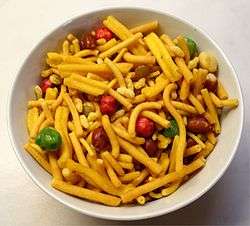Bombay mix
 Bombay mix | |
| Alternative names | Chanachur |
|---|---|
| Type | Snack |
| Place of origin | Indian subcontinent |
| Main ingredients | Fried lentils, peanuts, chickpea flour noodles, vegetable oil, chickpeas, flaked rice, fried onion and curry leaves |

Chaṇāchura in Odisha.
Mixture in Chennai
Bombay mix is an Indian snack mix which consists of a variable mixture of spicy dried ingredients, such as fried lentils, peanuts, chickpea flour ghatia (sev), corn, vegetable oil, chickpeas, flaked rice, fried onion and curry leaves. This is all flavoured with salt and a blend of spices that may include coriander and mustard seed.
In India, it is sometimes eaten as part of a meal; as a standalone snack, though, it is usually consumed with the hands.
The name "Bombay mix", referring to the city of Mumbai, is mainly used in the United Kingdom and Ireland. Names used in India for the mix include:
Variations
Alternative, regional versions include:
- In the United Kingdom and Ireland, the Bombay mix sold and served in Indian restaurants, take-aways and newsagents often does not contain dried fruit, although authentic recipes from Maharashtra do.
- In Afghanistan, it's called simyan and is eaten on visits.
- In Pakistan, it is very popular, prepared throughout the country, usually known as chevda (although chevda also refers to another foodstuff) or nimko.
- A different version, called gathia mix, and sometimes "Gujarati mix", is a lot spicier and contains only crunchy mix, peanuts and spices.
- In the United States, it is alternatively and more often referred to as "Punjabi mix" or simply "hot mix".
- In Myanmar, they are known as sarkalay chee, which literally means sparrows' droppings, referring to the lentil strips. They are very popular with both the Burmese and the Burmese Indians.
- In Sri Lanka, it is known just as "mixture", and includes a larger variety of exotic ingredients, such as cassava and fried curry leaves.
- In Malaysia and Singapore, it is known as kacang putih. Members of the local Indian community usually refer to it as "mixture" as is done in Southern India. It is available from roadside vendors as well as shops and restaurants. Singaporean supermarket Fairprice refer to their Bombay mix product as 'murukku', which is an entirely different product altogether.[1]
- In Bangladesh, it is known as Chanachur, which is very spicy compared to the other versions, and is much more popular amongst the Bengali people. It is one of the important ingredient of a popular Bengali snacks Jhalmuri
- In southern states such as Tamil Nadu and Kerala, it is known as just "mixture", and is available in almost all the sweet shops and bakeries. Usually it consists of fried ground nuts (peanuts), thenkuzhal,[2] kara boondhi,[3] roasted chana dal, karasev, murukku broken into small pieces, pakoda and oma podi.[4][5]
- In Eastern African countries with large populations of families of Indian descent, especially Kenya, Tanzania and Uganda, it is known as chevdo or chevra and is often prepared with some sugar sprinkled in.
- In South Africa it is popular amongst the Indian community of Kwazulu Natal and the Cape Malay community of the Western Cape. Amongst the Indian community it is known as "sev and nuts" and amongst the Cape Malay community as "slangetjies," which is Afrikaans for little snake and refers to the appearance of the chickpea flour noodles.
- A variation of chevdo without root vegetables (where the potato crisps are replaced by matoke (plantain) is defined as Jain chevdo.
- In Nepal it is known as "Dalmoth".
- Called Bhuja in Fiji. Also sold under the "Bhuja" brand in Australia.
See also
References
- ↑ catalogId=10051&storeId=90001&productId=314685&langId=-1&categoryId=33965&parent_category_rn=33965&top_category=10059 Product: FAIRPRICE - MURUKU THICK
- ↑ "Thenkuzhal Recipe". Subbus Kitchen. Retrieved 2014-02-02.
- ↑ "Diwali special – Kara Boondi (Spicy Boondi)". Samai.in. 2008-09-23. Retrieved 2014-02-02.
- ↑ "Oma Podi - Oma Podi Recipes, How to make Oma Podi". Food.sulekha.com. Retrieved 2014-02-02.
- ↑ "Padma's Recipes: OMA PODI / SEV". Padmasrecipes.blogspot.com. Retrieved 2014-02-02.
This article is issued from
Wikipedia.
The text is licensed under Creative Commons - Attribution - Sharealike.
Additional terms may apply for the media files.


